Workplace communication is one of the most important aspects of every business. With the emergence of remote work and dispersed workplaces, connecting and engaging with employees remains one of the biggest challenges faced by business leaders these days.
📚Check out our article about Why Employee Communications are the Better Internal Comms and learn how to communicate with the modern employee in today’s digital age.
Your internal communication is the cornerstone of your organization. Without an effective employee communications strategy in place, it becomes highly challenging — if not impossible — to foster collaboration, support your employees’ health and wellbeing, and help them stay productive.
The thing is, we’re not there yet.
Gallup has recently surveyed U.S. employees and the results of the survey are quite alarming. Only 39% of U.S. employees think that their employer has communicated a clear plan of action in response to COVID-19 and only 48% strongly agree that their immediate supervisor keeps them informed about what is going on in the organization.
To help you better navigate changes in the workplace, we are sharing best communication practices that we hope will help you better connect and engage with your employees.
But before that, let’s go through the reasons why communication in the workplace is business leaders’ top priority.
📙 Also read about the characteristics of great leaders.
Make workplace communication effortless with the right IC tools
The Importance of Workplace Communication
When talking about improving employee motivation, satisfaction, engagement and productivity, companies have mostly been focusing on employee recognition, feedback and appreciation.
However, are we focusing enough on continuous employee communication?
📙 Also read about the top priorities among internal communications professionals.
Workplace communication and employee productivity
Workplace communication affects many various aspects of the business. However, increased employee productivity is the most common reason why Chief Communication Officers and other communications professionals are investing in internal communications more than ever before.
On average, employees are 20 to 25% more productive in organizations with effective internal communication in comparison with companies where employees are not connected.
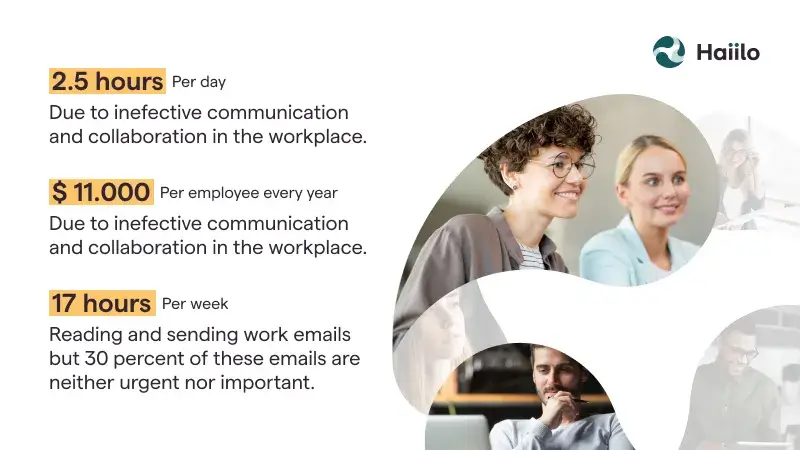
Workplace communication and employee motivation
When we talk with enterprise companies, one of the challenges that always comes up is how to keep employees motivated and engaged.
One of the best ways to keep your employees motivated is by making sure they are informed about important happenings within your organization.
📚Read on: Top 15 Employee Motivation Tips and Benefits
What’s more, 85% of employees say that they are most motivated when management and leadership offer regular updates on company news.
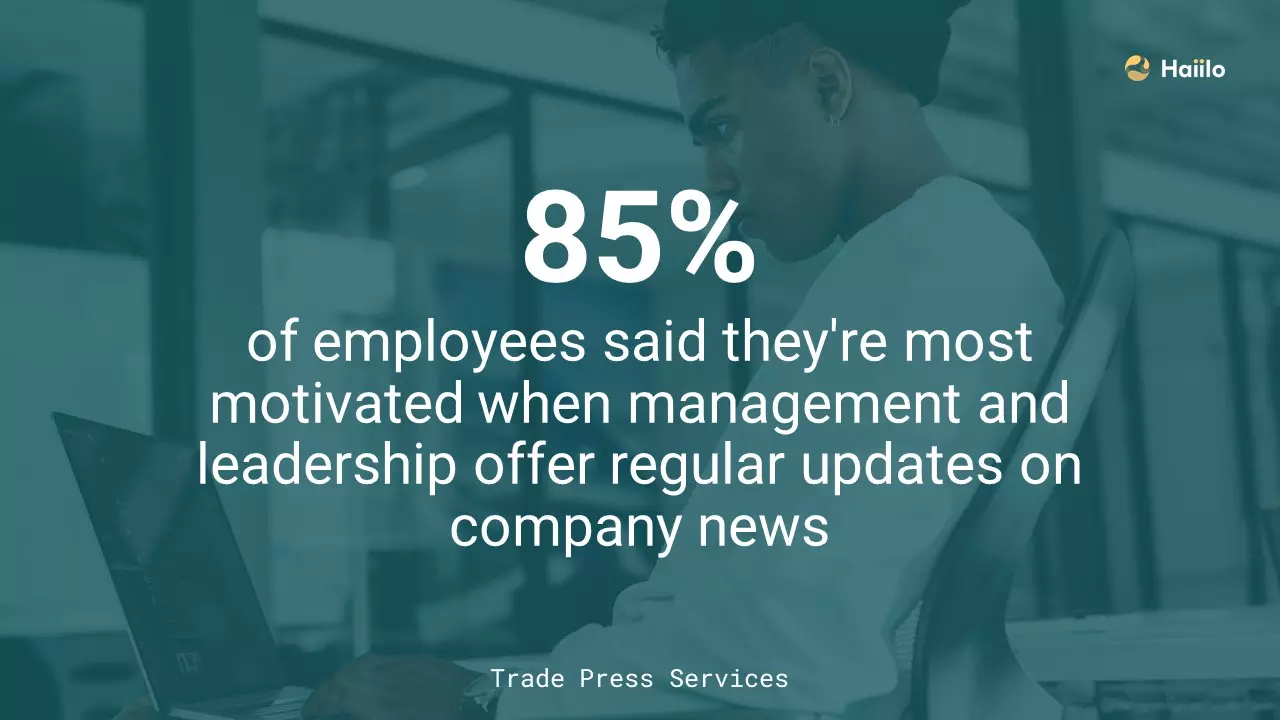
Workplace communication and business profitability
Poor workplace communication has a negative effect on business performance and profitability. In other words, the cost of poor internal communication is extremely high.
A survey of 400 companies with 100,000 employees cited an average loss per company of $62.4 million per year because of inadequate communication to and between employees.
Moreover, according to a report by global risk-management and advisory company Willis Tower Watson, companies with effective communication practices generate 47% higher total returns to shareholders compared to organizations with poor communication.
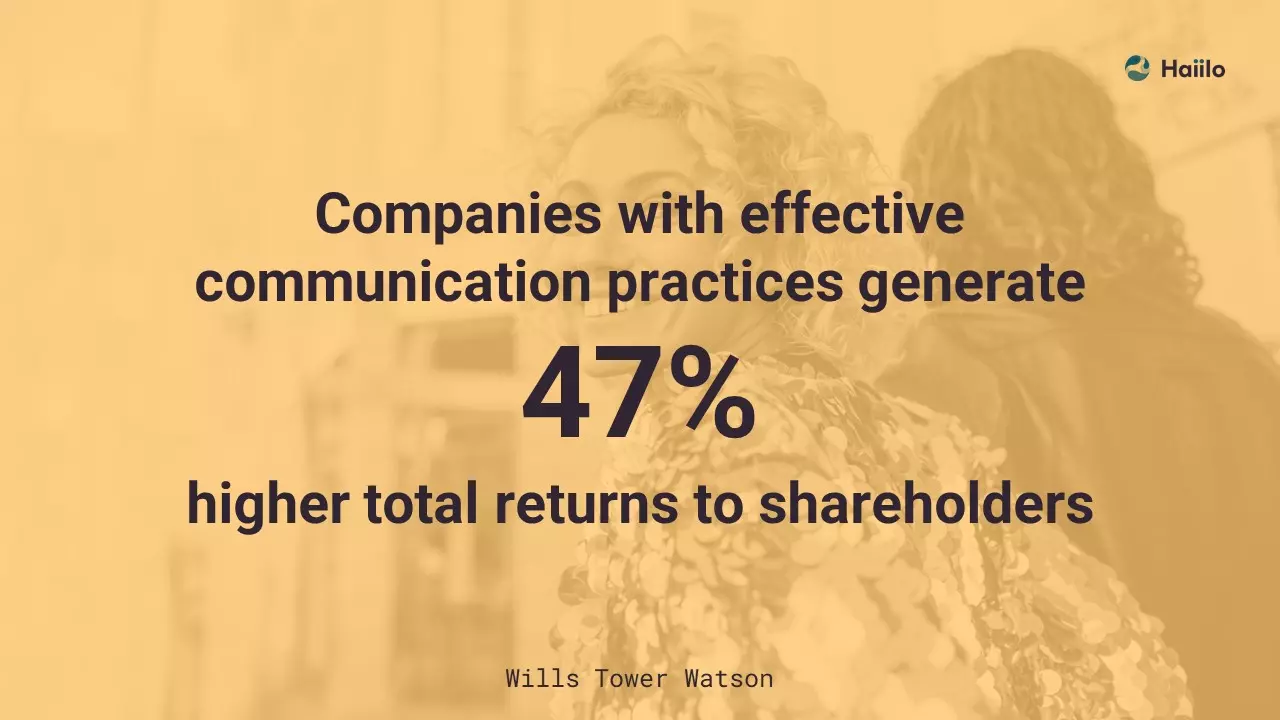
Workplace communication and customer satisfaction
Informed employees are much more likely to build better connections with customers and work harder to improve customer experience. Moreover, they often have much better interpersonal communication skills.
As a consequence, customer retention rates are 18% higher when you have well-informed and highly engaged employees. This is why many organizations now agree that employee experience is the new customer experience.
Effective Communication in the Workplace [INFORGRAPHIC]
In the previous section, we covered just some of the benefits of proper communication in the workplace. However, there are many more benefits that many organizations are not even aware of. Some of them include eliminating communication silos, improving knowledge sharing in the organization, and boosting employee advocacy and ambassadorship.
Therefore, it is inevitable that companies need to invest more time and effort in their employee communication efforts. They need to better understand how to adjust communication to the new business environment and multigenerational workforce.
Take a look at the infographic below for the entire list of benefits. 👇

3 Ways Communication in the Workplace is Changing
Most businesses have asked their employees to work from home due to COVID-19 restriction and potential exposures. As a result, this shift to remote work has led to changes that are here to stay.
Simply put, the way we work won’t be the same as it was before the outbreak.
📚Read on: Change Management: Definition, Best Practices & Examples
One of the main reasons why there’s no such thing as “back to normal” is because most companies are continuing offering flexible work arrangements. Remote work is becoming the new norm.
That means several things for businesses:
1. They’ll have to rethink their IC strategies
One of the biggest changes we may see in the near future is the adoption of new internal communication tools by most companies. That’s because emails and even video conferencing tools won’t be enough to keep businesses running smoothly.
When companies asked their employees to work from home, most of them started equipping their teams with video conferencing tools to make meetings easier to handle remotely.
But remote collaboration isn’t limited to one-on-one or team meetings.
The current world situation is drastically reshaping the workplace and that means that IC teams will need to find the right ways to:
- Effectively communicate safety and security procedures to employees.
- Help employees keep up with what other teams are working on so they can better align their efforts to meet the deadlines. Welcome to the era of cross-functional collaboration!
- Make it easy for employees to keep up with the company news so they have a good understanding of where the company is headed and they don’t feel disconnected from the rest of the workforce.
📚Read on: Remote Work: 20 Ways to Engage and Connect with Your Remote Employees
2. Helping employees to find the right work-life balance will be one of their top priorities
As remote work is most likely here to stay — at least partially, IC and HR teams will have to help employees find the right balance between their professional and personal lives.
Research shows that when working remotely, people tend to be more productive. For example, HubSpot found that 77% of employees feel they are more productive when working from home. But for most of them, that means they work longer hours.
According to Business News Daily, remote employees work 1.4 more days per month than their office-based counterparts, resulting in more than three additional weeks of work per year.
As a result, 29% of remote employees said they struggle with work-life balance, and 31% said they have needed to take a day off for their mental health.
As remote work is here to say, there’s no doubt HR and IC teams will develop new processes to support employees in their daily work and protect their mental health and wellbeing with effective workplace communication.
📙 Also read our ultimate management communication guide.
3. IC and HR teams will have to develop new ways of onboarding new hires
Onboarding is a critical step. Employees’ first impression about the company has a direct impact on their willingness to stay at the company.
Effective onboarding improves new hire retention by 82%. What’s more, new employees who are part of a well-structured onboarding orientation program are 82% more likely to remain at a company for up to three years.
📚Read on: 8 Employee Engagement Statistics You Need to Know in 2020 [INFOGRAPHIC]
20 Tips to Improve Communication in the Workplace
Let’s now take a deep dive into what you can do to successfully communicate with your employees:
1. Improve your communication skills
Managing people without strong communication skills is impossible. Yet, 91% of employees say that their leaders lack communication skills. Therefore, every manager should continuously upgrade and work on his or her communication skills.
📚Read on: Top 5 Communication Skills and How to Improve Them
2. Ask for and give feedback
Feedback is crucial for driving employee engagement, productivity and retention. However, 4 out of 10 employees are actively disengaged when they get little or no feedback.
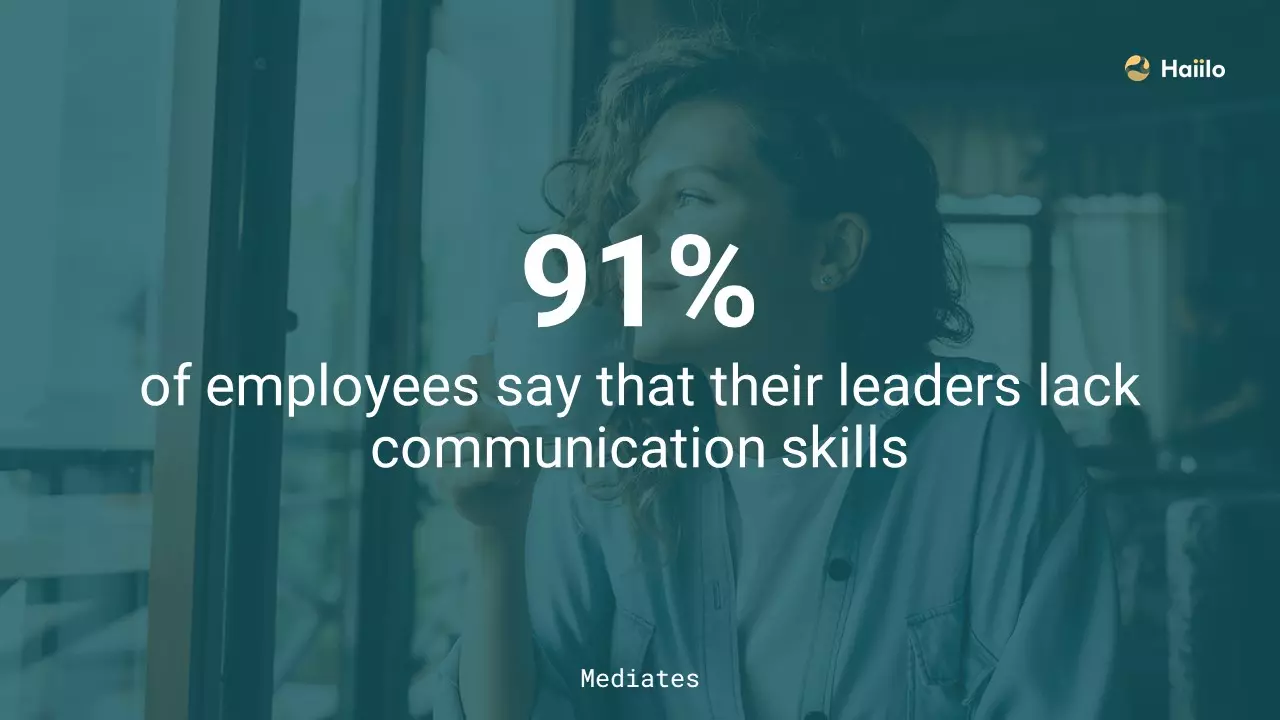
As we all strive towards making our employees more engaged at work, managers should see feedback as one of the best ways to improve workplace communications.
3. Help your employees understand the business strategy
Effective workplace communication strategy is the one in which employees understand and align with business strategy and goals.
However, IBM found that today, 72% of employees don’t have a full understanding of their company’s strategy.
4. Build trust to align your employees with the company values
Workplace communication has a direct impact on employees’ trust towards their leaders.
Moreover, 93% of workers said trustworthy leadership was the most critical factor in creating alignment, with 93% saying it’s important but just 61% feeling their companies are aligned with their values.
Not convinced about the importance of trust in the workplace?
Here is more proof…
A study found that, compared with employees working at low-trust companies, employees working at companies that cultivate trust:
- Feel 74% less stressed
- Are 106% more energetic at work
- Are 50% more productive
- Are 13% less willing to call in sick to work
- Feel 76% more engaged
- Report a 29% higher satisfaction with their lives overall
- Are 40% less likely to cope with burnout
5. Connect your team members
Managers should always strive towards improving connections and conversations among their team members.
Millennials and Gen Z are sociable and team-oriented.
Moreover, when millennials were asked about what they want from their workplace, interactions with their colleagues was extremely important to them.
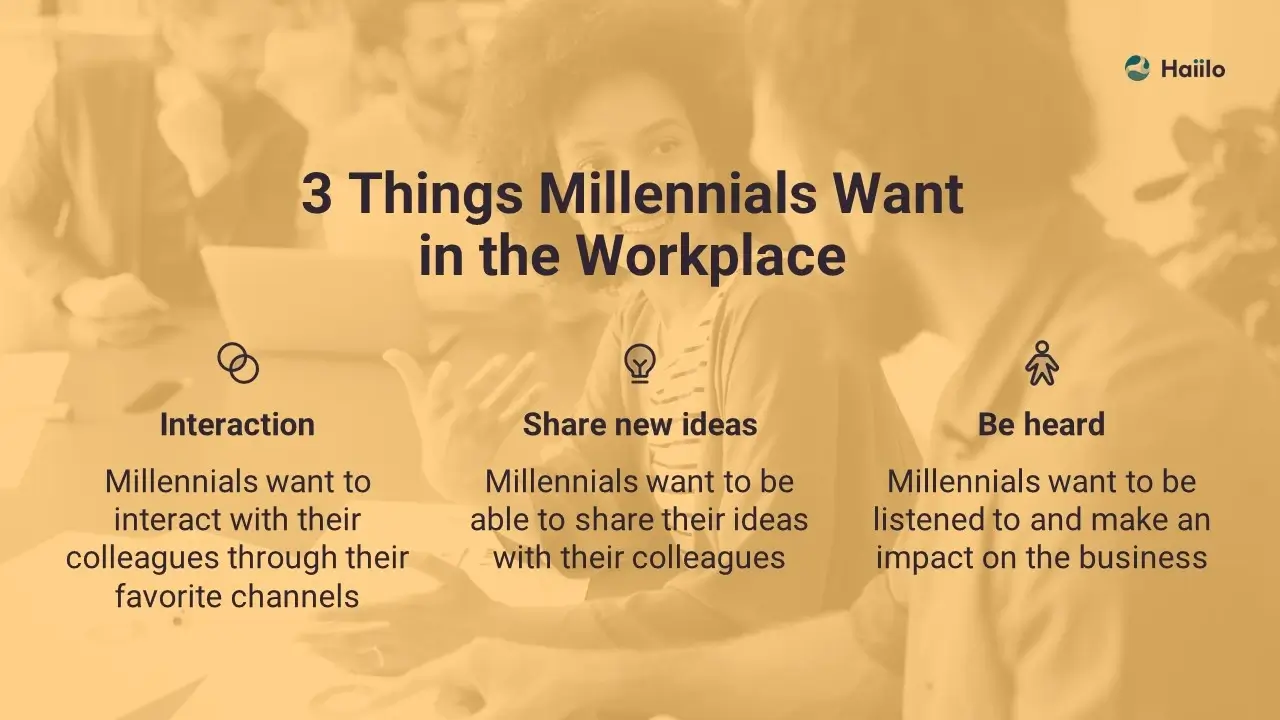
Therefore, managers should enable them to connect and collaborate more efficiently.
Choosing the right communication channels to communicate with your team makes a huge difference here.
6. Choose the right communication channels
Managers need to understand that millennials and Gen Z make up the majority of today’s workforce. Have you adjusted your communication strategy based on their preferences and habits?
The same way they expect their favorite social media channels to deliver information relevant to their interests, they expect workplace communication to do the same; they want important information to find them!

Choosing the right communication channel is crucial here. However, this can be hard to achieve with so many channels we use in the workplace today.
Unfortunately, emails that still make some of the main workplace communication channels are outdated and have low employee adoption rates.
What you can do with the right communication solution such as Haiilo, is connect all of your communication channels into a central place for employee communication.
7. Listen to your employees
Managers should always try to make their employees feel like they can speak up and express their thoughts and opinions.
However, not many employees feel that way.
Roughly half of employees aren’t regularly speaking their minds at work. Only 52% of employees say that they always or almost always speak their minds when having work-related conversations with their leaders.
8. Enhance dialogues and two-way conversations
You, as a manager, should not be the one always having the main word.
To run a successful internal communication, you’ll need to build two-way relationships with your employees.
Even though HR and IC practitioners have a job to build the internal communications strategy to strengthen employee experience at the company level, managers also play an important role in internal communications.
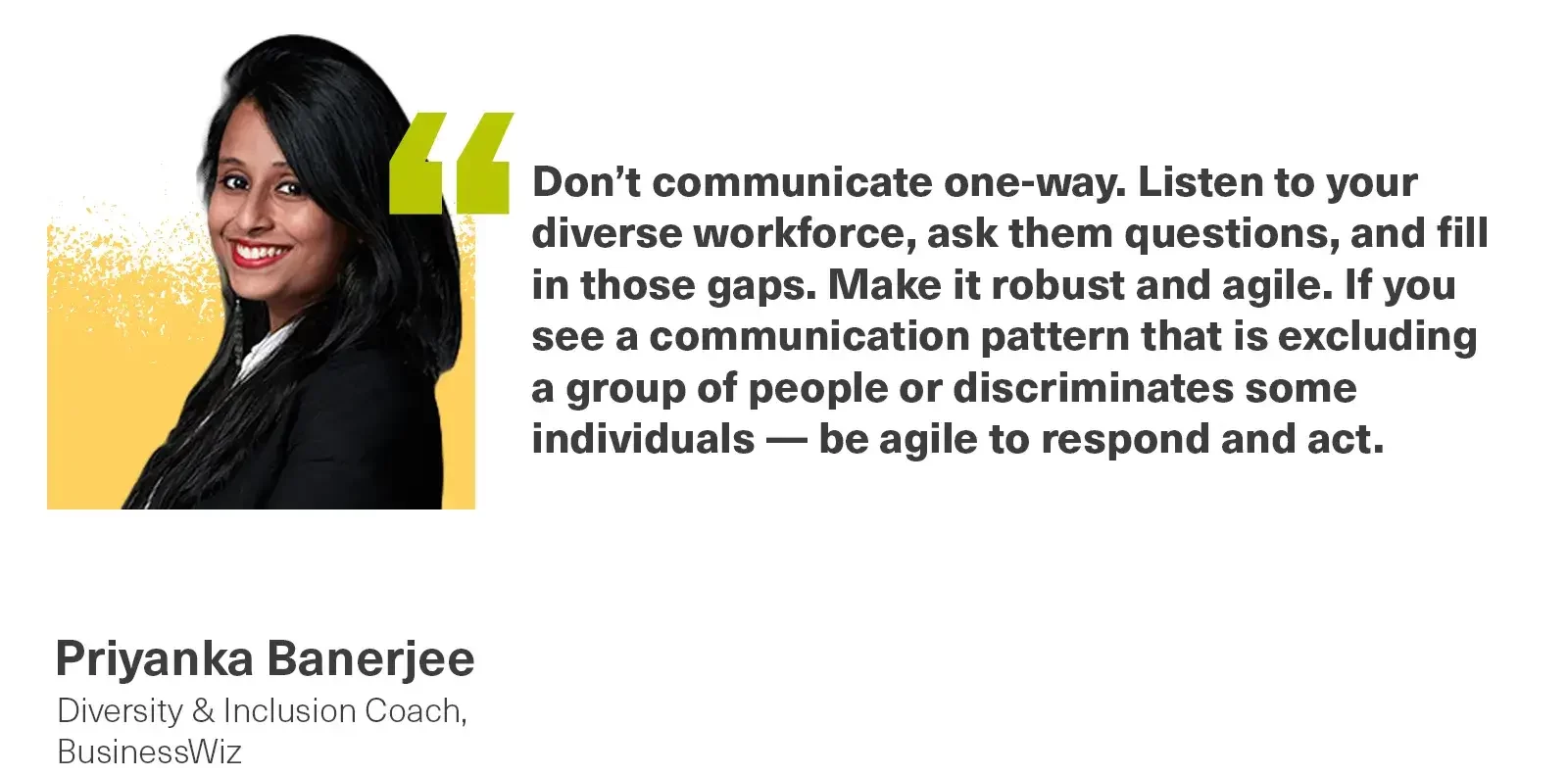
At the end of the day, managers are the ones with whom employees have conversations on a daily basis.
Therefore, manager’s job is to continuously encourage employees to engage into two-way conversations.
Remember that employees mostly leave their companies because of poor relationships with their managers.
Moreover, only 12% of employees who have quit their jobs did so to negotiate higher salaries somewhere else while 75% quit their job because of the bad relationship with their direct supervisor.
9. Communicate regularly
Regular communication is the most important prerequisite for the effective workplace communication and employee-manager relationships.
Employees expect much more from their leaders when it comes to regular communication.
This is not surprising that only 17% of employers think line managers are good communicators.
📙 Also read about the 11 reasons why business communication is crucial for business success.
10. Make content relevant to your employees
When employees don’t engage with internal content, it is either because it is hard to find it or because it is not relevant to their job, interests or priorities.
Therefore, sharing relevant content with your employees is crucial to improve employee engagement.
Managers should now consider new employee communication solutions that enable them and their employees to create personalized news feeds with content that employees will actually consume.
Helping employees and managers to easily filter and organize content based on their preferences makes workplace communication much more effective.
11. Connect various channels into a central employee communications platform
Managers at large organizations often use multiple communication channels to communicate with their teams.
This overload of various communication channels such as email, document sharing and private messaging tools often makes employees confused and overwhelmed.
Did you know that important and relevant emails make only 38% of employees’ inboxes?
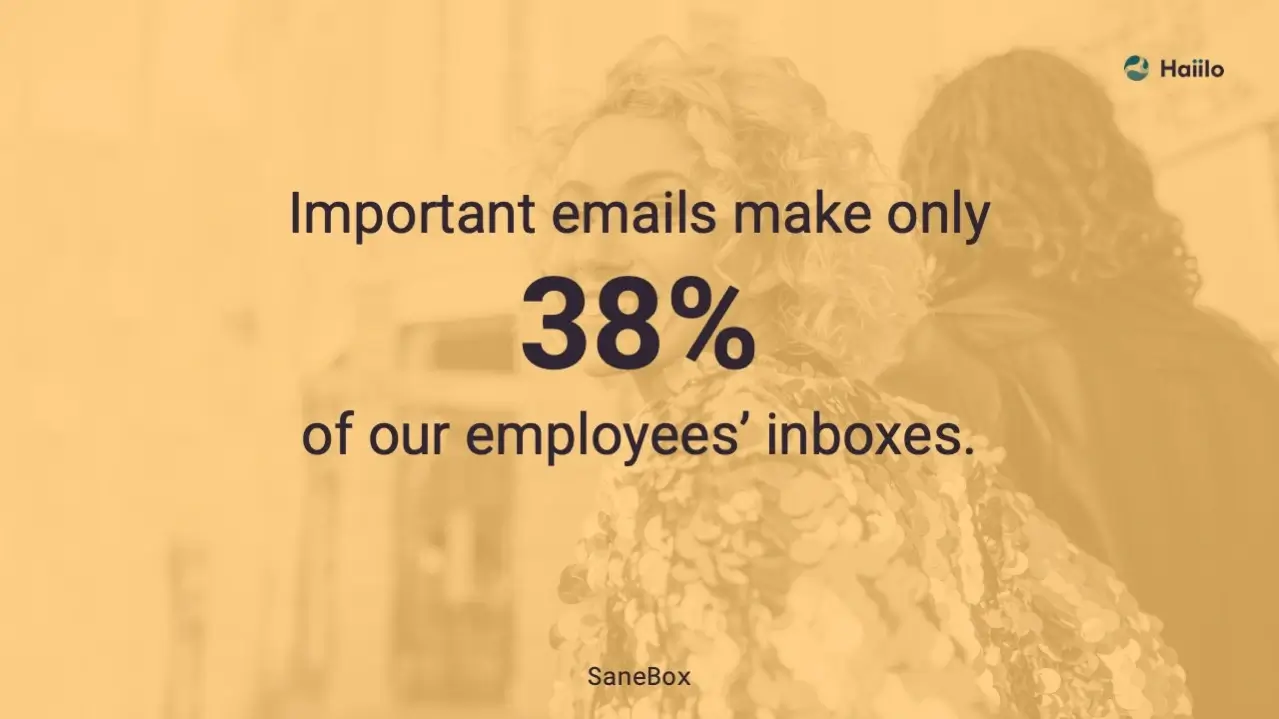
If you want to improve workplace communication with your team, consider implementing an internal communication solution that connects all those channels.
Help your employees have a central place to find important information.
12. Make important information easily accessible
In order to improve workplace communication, managers need to improve the way they deliver information to their employees.
Extensive search for relevant information causes significant losses in employees’ productivity and motivation.
Luckily, employee communication tools like Haiilo enable managers to ensure that important information is always at their employees’ fingertips.
13. Recognize good work
Employee recognition makes employees go the extra mile and it builds trust between employees and managers.
Not only that recognition improves workplace communication, but employees who get recognized by their managers engage by up to 60% more.
14. Spread positivity in the workplace
Practicing positivity and optimism in the workplace leads to numerous health benefits, increased productivity, and less stress. Optimistic employees are also happier and more involved in their work, so one of the most important traits a manager can have is to spread positivity among their teams.
Managers who promote positivity can help their employees start looking on the brighter side of things.
Positivity is contagious!
15. Act on your promises
In order to maintain credibility, respect, and trust gained through open and honest communication, managers need to back up their words with actions.
Promising something and not executing on the word is the main reason why employees lose trust in their managers.
16. Measure your communication efforts
Even though it can be tricky to measure your workplace communication efforts, there are still some things you can track to get a better understanding of what is working and what is not.
For example, tracking engagement around your content is a good way to get started with IC analysis. If the engagement is low, that probably means that the content is not interesting or relevant to your team members.
However, 41% of internal communication practitioners have no way of tracking user activity or making sure that content uploaded to their internal communication platforms is read by employees.
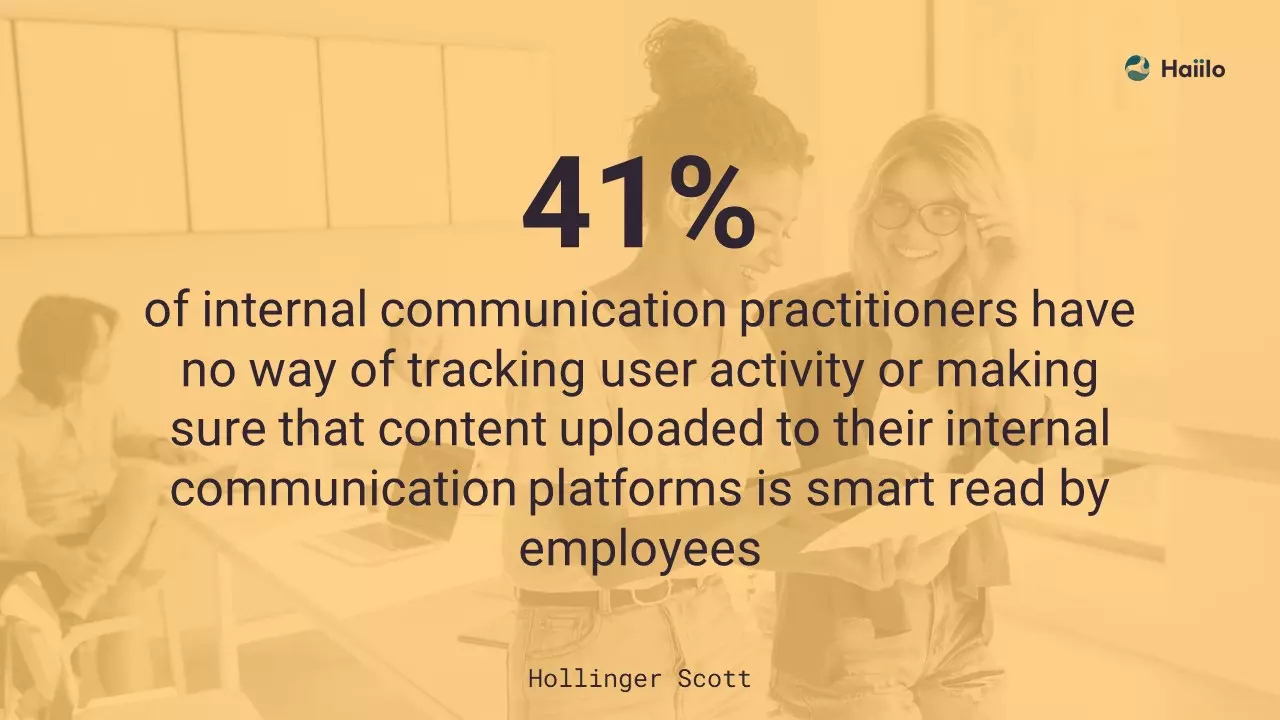
Luckily, modern internal communications solutions like Haiilo enable managers and IC departments to get valuable employee engagement insights based on real data.
17. Don’t neglect one-on-ones
Gallup has found that 70% of the variance in employee engagement is caused by a person’s manager.
1:1 meetings between managers and their team members can solve many problems related to employee engagement.
For example, Adobe and GE have both previously made a lot of noise in the press about their moves to get rid of performance reviews. When they did, they switched to having their managers do frequent 1:1 meetings instead.
The impact was significant in both cases:
- Adobe “saw a 30 percent reduction in voluntary turnover.”
- GE was able to “drive a fivefold productivity increase in the past 12 months.”
18. Think mobile
Currently, millennials represent 50% of the global workforce and by 2025, that number will reach 75%. Something that we are all sure about millennials, is that they are mobile-oriented.
Therefore, if you want them to engage with the content you share, you have to match your communication efforts with their habits. In other words, managers should now consider implementing mobile-first communication solutions.
19. Keep your remote employees in the loop
As most employers today have either full or part-time remote employees, it is important to have a strategy on how to keep them connected with the rest of the team and how to make sure that relevant information reaches them at the right moment.
Why is this so important?
20% of remote employees say that they lack a sense of belonging and sometimes feel lonely.
Therefore, managers should help their remote employees always get timely and relevant information.
20. Be approachable
Sometimes, employees may think that their managers are unapproachable. This happens in situations where managers react negatively to employee complaints or concerns, do not allocate enough time to one-on-ones or take too long to respond to employee questions or emails.
When employees hesitate to talk to their managers, low engagement and conflicts may happen.
Consequences of Poor Workplace Communication
Results of a major report revealed that one-half of employees have “great” or “excellent” conversations at work. The other half deemed their conversations as “mediocre,” “poor” or “bad.”

Another survey with executives, managers and junior staff members found that communication breakdowns in the workplace have multiple downsides. When asked about the consequences of poor communication:
- 52% of respondents said they feel higher stress levels.
- 44% said they failed to complete their projects.
- 31% said they missed their performance goals.
- 20% said that they experience obstacles in innovation.
- 18% said that they lost new sales opportunities.
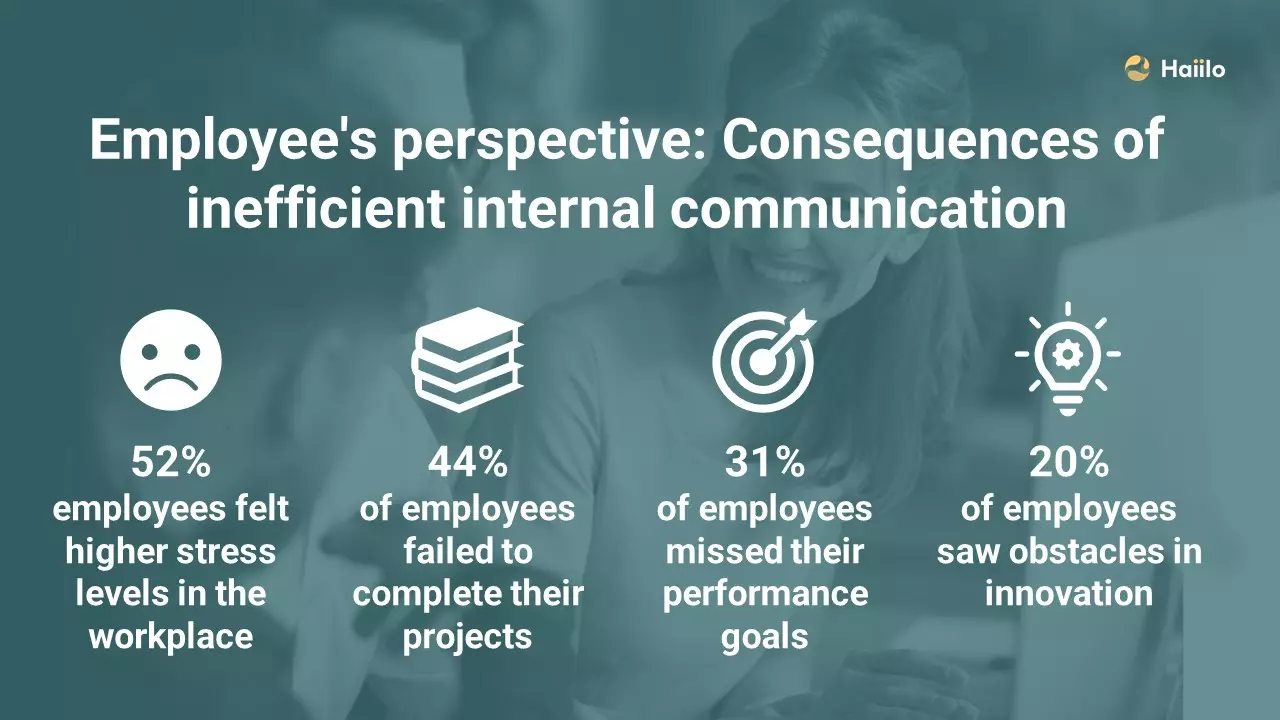
15 Challenges with Communication at Work
As seen earlier, effective workplace communication can go a long way in driving better business results. However, poor communication at work can have many downsides.
As workplace communication plays one of the most important aspects of employee experience and satisfaction, eliminating those challenges has become one of the most important business priorities. Leaders, managers and other communicators have become important strategic business partners in ensuring business continuity.
Paired with the right workplace technology, their communications skills and expertise can drive more engagement in the workplace.
But what are the biggest challenges when it comes to communication at work? Here they are:
- Ensuring that the right information reaches the right employees at the right time
- Reaching hard-to-reach employees such as blue collar and remote workers
- Moving away from one-way conversations and implementing two-way communication approach
- Delivering highly targeted content based on the target audiences
- Cutting through the noise and catching employees’ attention
- Building mobile-friendly workplaces
- Measuring the impact of workplace communication
- Eliminating information overload
- Enabling knowledge workers
- Improving cross-functional communication and collaboration
- Empowering employees to become brand ambassadors
- Making leadership communication more inviting and authentic
- Enabling managers to be approachable and always stay connected with their teams
- Managing grapevine communication
- Reducing time spent on search for information
Improve Your Workplace Communication with the Right Technology
Overall, just 24% of IC professionals think that they’re using their communication channels in an effective way.
One of the main reasons for such a low number is the fact that many organizations today use multiple communication channels but don’t have a central place to communicate with their employees.
As a consequence, companies spend a lot of resources on creating and distributing content that doesn’t end up getting the attention it deserves.

Haiilo does exactly that: it connects your communication channels such as email, document sharing, messaging and other communication tools into a central employee communication platform that drives higher employee engagement with internal content. Another reason why many IC strategies don’t work is the fact that organizations still haven’t fully adapted their workplace communication strategies to their employees’ needs and preferences.
Not enabling employees to always have access to important company information on their smartphones causes lower engagement and consumption rates with the internal content being produced.
To add, most organizations still don’t have ways to measure how effective communication in their workplaces is. They don’t have ways to tie communication efforts to specific business goals and strategies. Luckily, modern, AI-powered employee communication technology enables communicators to better understand the ROIs of internal communications and get valuable insights for improvement.
Haiilo is an employee communications platform that helps you to manage the information flow within your organization, preventing important information from getting lost and reducing information overload.
Start improving your workplace communication efforts today and schedule a Haiilo demo! Learn about how organizations across the world use Haiilo to drive positive employee experience and achieve better business results.











